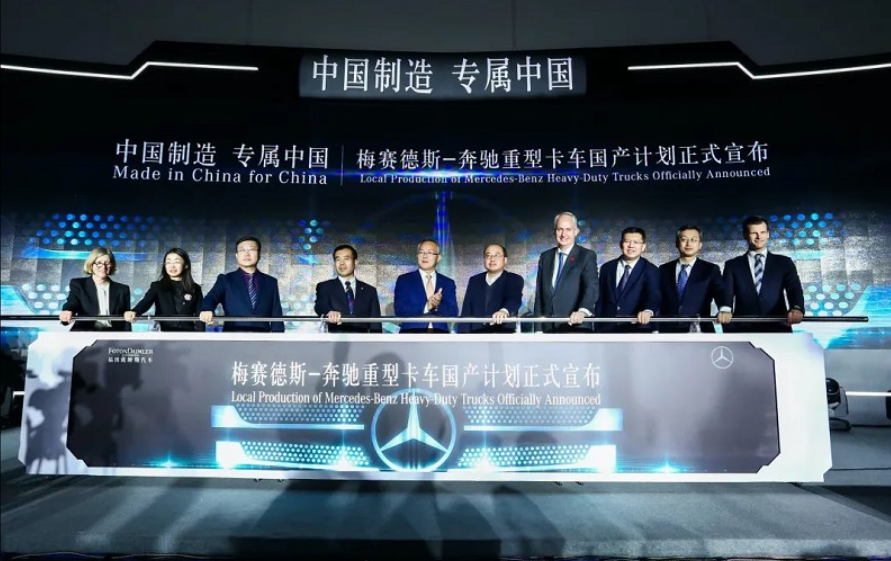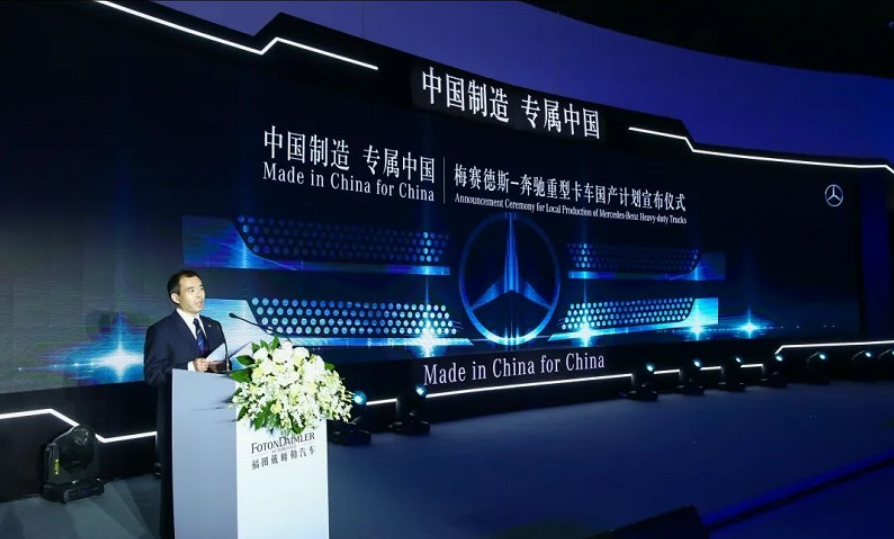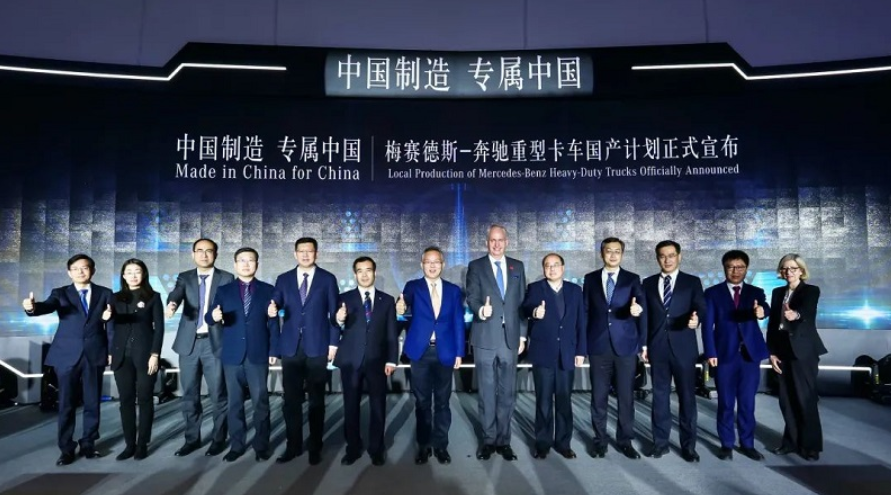Daimler Trucks' withdrawal of investment from Foton
Daimler Trucks' withdrawal of investment from Foton: Behind the shatters of a 13-year joint venture dream lies the predicament of foreign commercial vehicles in China.

When Karin Radstrom, CEO of Daimler Trucks, proposed it in an interview with《Manager Magazine》When making the declaration of "divesting from underperforming joint ventures in China"Although no names were mentioned, the industry has tacitly agreed,The Sino-German commercial vehicle collaboration that began in 2012 is now coming to an end.Beijing Foton Daimler, a joint venture in which each party holds a 50% stake, once carried the ambition of localizing Mercedes-Benz's heavy trucks, but now it has become a footnote to Daimler's global strategic contraction.The 13-year cooperation has come to an end. What remains is not only the sunk cost of the initial investment of 6.3 billion yuan, but also reflects how foreign giants have transformed from technological benchmarks into typical cases of "culture shock" in the rapidly changing Chinese commercial vehicle market.
Technology for Market: An unfinished Mutual Pursuit
In 2012, when Daimler and Foton formed a joint venture with a 50:50 equity stake, the blueprint they drew up was quite alluring,
Daimler exports core technologies such as the OM457 engine, while Foton contributes the Foton Auman brand and a network of over 300 dealers. With a "dual-brand strategy", it aims to capture the high-end heavy truck market in China.This seemingly perfect "technology for market" model has been fraught with cracks since its inception.The 490-horsepower OM457 engine, originally scheduled for mass production in 2014, was eventually put on hold due to Daimler's technology retention policy.Without the support of core power, the Foton Auman heavy-duty truck had no choice but to switch to Foton Cummins engines, which directly led to a gap in product competitiveness.Ironically, the localization process of the Mercedes-Benz brand has been slow. The Actros truck, which was only launched in China in 2022, has seen its monthly sales per store consistently hovering in single digits, in sharp contrast to the best-selling models of domestic brands such as Sinotruk and Shaanxi Automobile.
The implementation of the dual-brand strategy is even more in a dilemma: The Mercedes-Benz brand adheres to the European pricing system, resulting in the terminal selling price being over 30% higher than that of its competitors.The Foton Auman brand, however, is constrained by the decision-making process of the joint venture and lags behind in responding to changes in market demand.During the recovery period of the heavy truck market in 2023, when domestic enterprises could complete order responses within 72 hours, Foton Daimler's approval chain still needed to communicate across the ocean, thus missing the market window period.

Triple Dilemma: The Transformation Pains of Foreign Giants,The time gap in the new energy vehicle sector
Daimler clearly underestimated the pace of change in China's commercial vehicle market,When BYD's electric dump trucks had already achieved large-scale operation in Shenzhen and Geely Remote's new energy heavy-duty trucks won port orders, it was not until 2023 that Foton Daimler launched its first electric model.This lag stems from two points:One is a misjudgment of Chinese users' "range anxiety", insisting on blindly copying the European 400-kilometer range standard while ignoring the domestic logistics scenario's essential need for an 800-kilometer range.The second issue is the insufficient localization of the supply chain. Core components such as batteries rely on imports, which leads to persistently high vehicle costs.Even though the domestic Actros launched in 2022 underwent "China Special Supply" modifications - widening the berths to meet the needs of long-distance drivers and adjusting the engine to be compatible with domestic low-octane diesel - these "superficial improvements" failed to touch the essence.Under the wave of new energy, the technological advantages of traditional fuel vehicles are rapidly eroding, and Daimler's technological barriers have been completely broken through by the electrification innovations of domestic enterprises.
The sandwich effect of the management structure
The governance predicament of the joint venture company was fully exposed during the period of market volatility.When the industry was in a downturn in 2023, dealers repeatedly requested to relax the payment collection cycle. However, due to the decision-making differences between the management teams of China and Germany, it could not be implemented for a long time. Eventually, 15% of the dealers withdrew from the market.Behind this inefficient decision-making lies the collision of two management systems: Daimler's insistence on European compliance processes is in sharp opposition to the "flexible and adaptable" survival rule of the Chinese market.
More crucially, the mismatch in strategic priorities between the two sides is becoming increasingly evident.Foton hopes to accelerate its transformation to new energy, while Daimler is more inclined to maintain the technological premium of fuel vehicles.Foton advocates penetrating third-and fourth-tier markets, while Daimler insists on focusing on first-tier cities. This fundamental divergence has gradually led the joint venture to lose its direction in the fierce market competition.

The incompatibility in the cost-performance battlefield
The core demands of Chinese heavy truck users have always revolved around "ton-kilometer cost", which conflicts with Daimler's product philosophy.The comfort features and long life cycle design that the European market emphasizes have, in the mind of Chinese users who pursue "carrying more and running faster", instead become a burden that increases the purchase cost.Data shows that the three-year retention rate of the domestic Actros is 12 percentage points lower than that of the Shaanxi Automobile Delong X5000. This disadvantage in terms of cost performance has directly discouraged a large number of individual car owners.Daimler's production system is also difficult to adapt to the pace in China.The "order-based production" model it adheres to takes 8 to 10 weeks from placing an order to delivery, while local enterprises can achieve delivery within 15 days through flexible production lines.In the heavy truck market where "ready-made vehicles reign supreme", such a time difference is sufficient to determine the ownership of market share.
Exit Revelation: The Transfer of sovereignty in China's commercial Vehicles
Daimler's divestment is not an isolated incident but a microcosm of the strategic adjustments made by foreign commercial vehicle enterprises in China.From MAN Commercial Vehicles' contraction of its business in China to Scania's slowdown in localization, foreign brands are gradually shifting from being "technology leaders" to "market followers".Behind this lies a qualitative change in China's commercial vehicle industry:From a technical perspective, Weichai Power's hydrogen fuel cell system and BYD's Blade battery technology have achieved partial overtaking of international giants.At the market level, in 2024, China's sales of electric heavy-duty trucks will account for 65% of the global total, and an industrial ecosystem led by domestic enterprises will have initially taken shape.
At the model level, NIO Trucks' battery swapping network and Geely Remote's smart logistics platform are reshaping the dimensions of industry competition.The 13-year cooperation history of Foton Daimler is just like the adaptation history of foreign brands in China:From an initial technology exporter to a follower of rules later on, and eventually becoming a cast-off for strategic adjustment.
This conclusion might not be the end, but rather the starting point for China's commercial vehicle market to truly enter a new stage of "domestic dominance and global competition"When domestic enterprises can simultaneously offer technological innovation and market response speed, the halo of foreign brands will eventually fade away, leaving behind a fairer yet more brutal arena.
相关阅读
- 宁德时代尖端三电技术赋能 庆铃铃坤纯电轻卡深圳发布
- 从燃油到纯电 深圳用户见证庆铃铃坤品质传承
- 15升、16升大排量的发动机真的是未来发动机的发展趋势吗?
- 搭载10升排量发动机的长城重卡竟然拥有970匹马力,超低油耗更是有图有真相
- Analysis of the Auto Export Market from January to April 2025
- 长城重卡的价格给不给力我不知道,但是它的售后政策真的是太给力了!
- 长城混动重卡终于发布了,亲临现场带卡友看看混动重卡究竟可以覆盖哪些工况。
- Dongfeng Commercial Vehicle's market breakthrough is accelerating again


发表评论 取消回复